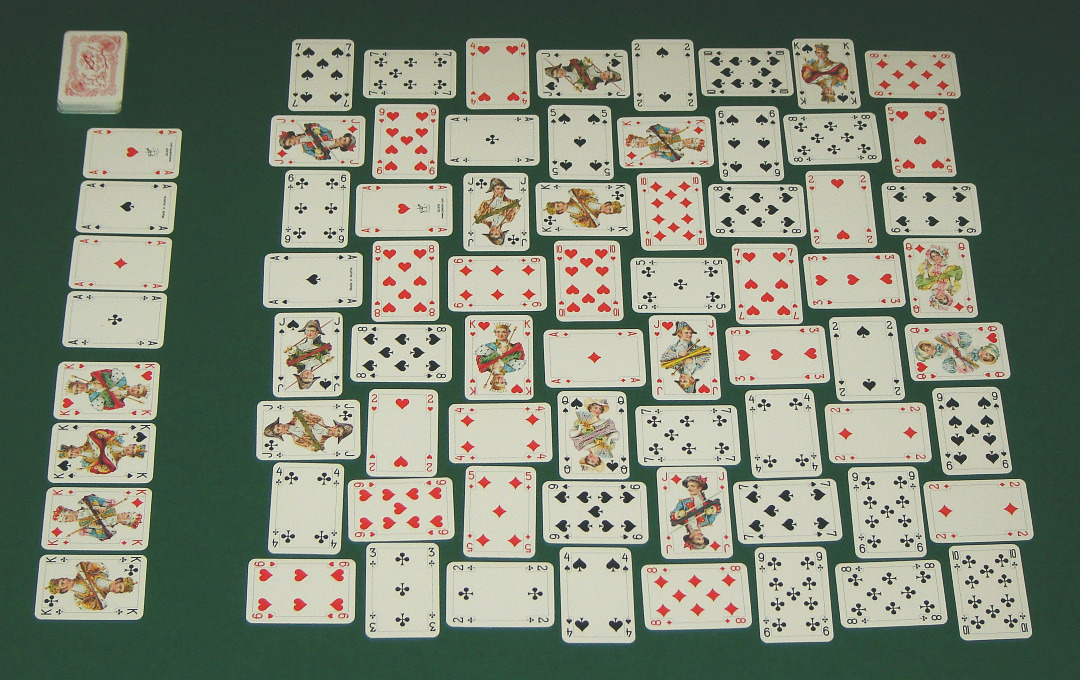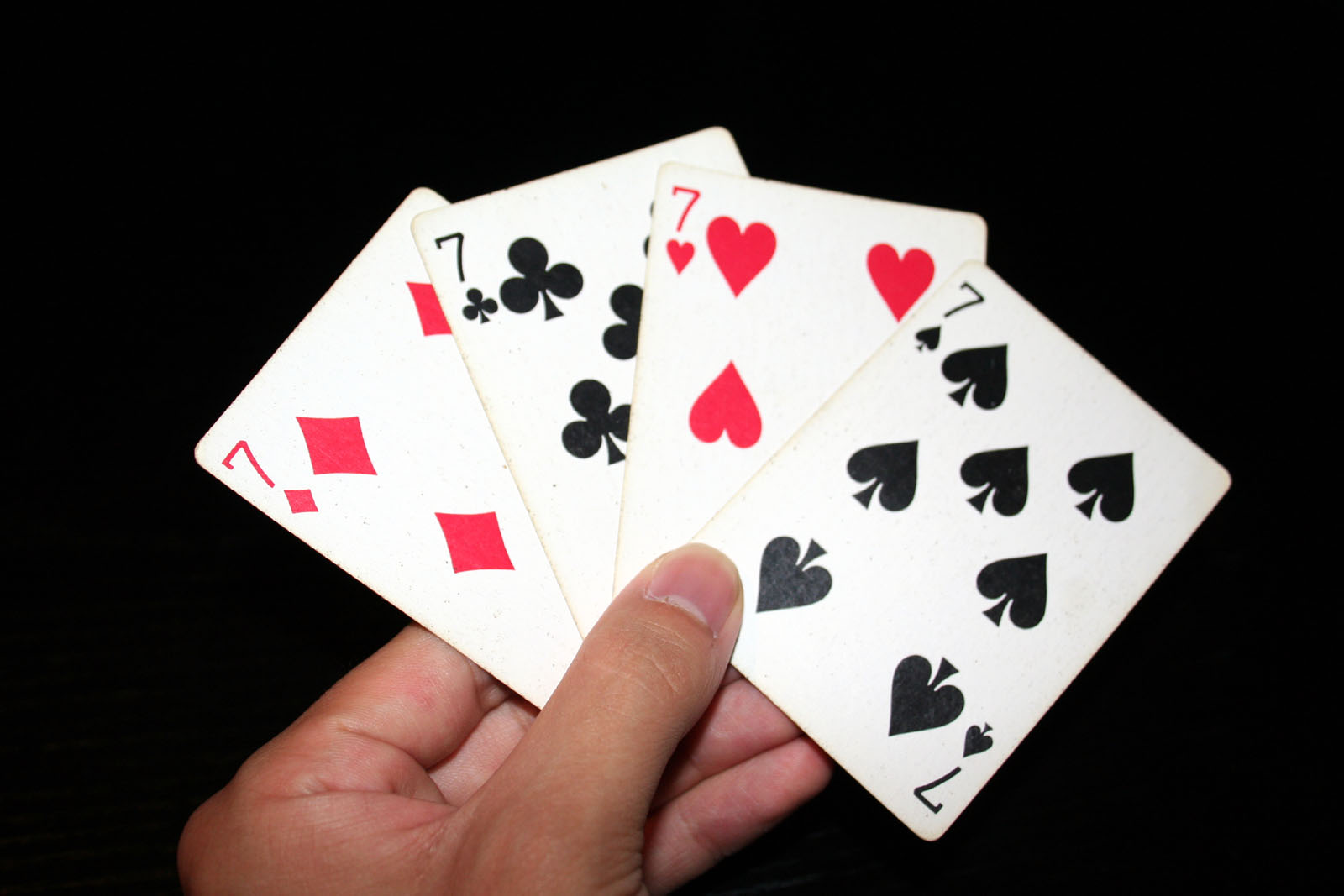|
Royal Marriage
Royal Marriage is a Patience game using a deck of 52 playing cards. It is an eliminator game in the style of the solitaire game Accordion. The game is so called because the player seems to remove anything that comes between the Queen and the King of the same suit for them to "marry." It also goes under the name Royal Wedding or Matrimony."Matrimony" (p.59) in ''The Little Book of Solitaire'', Running Press, 2002. Rules The Queen of the chosen suit (traditionally the Queen of Hearts) is placed immediately on the table face-up while her corresponding King is placed face-down. The remaining fifty cards are shuffled and placed on the top of the King to form the stock. Cards are dealt from the stock one at a time to the right of the Queen. If a pair of cards with either the same rank or suit are separated by one or two cards, the in-between cards may be discarded. This may result in new opportunities to discard additional cards. Strategy revolves around decisions of whether to disc ... [...More Info...] [...Related Items...] OR: [Wikipedia] [Google] [Baidu] |
Patience (game)
Patience (Europe), card solitaire or solitaire (US/Canada), is a genre of card games whose common feature is that the aim is to arrange the cards in some systematic order or, in a few cases, to pair them off in order to discard them. Most are intended for play by a single player, but there are also "excellent games of patience for two or more players". Name 'Patience' is the earliest recorded name for this type of card game in both British and American sources. The word is French in origin, these games being "regarded as an exercise in patience." Although the name solitaire became common in North America for this type of game during the 20th century, British games scholar David Parlett notes that there are good reasons for preferring the name 'patience'. Firstly, a patience is a card game, whereas a solitaire is any one-player game, including those played with dominoes or peg and board games. Secondly, any game of patience may be played competitively by two or more players. Am ... [...More Info...] [...Related Items...] OR: [Wikipedia] [Google] [Baidu] |
Glossary Of Solitaire
Games of patience, or (card) solitaires as they are usually called in North America, have their own 'language' of specialised terms such as "building down", "packing", "foundations", "talon" and "tableau". Once learnt they are helpful in describing, succinctly and accurately, how the games are played. Patience games are usually for a single player, although a small number have been designed for two and, in rare cases, three or even four players. They are games of skill or chance or a combination of the two. There are three classes of patience grouped by object. The most frequent object is to arrange the cards either in ascending sequence (e.g. from Ace to King) or descending sequence. Occasionally both forms of sequence are aimed at in the same game. The card forming the starting point of the required sequence is known as the foundation card and the sequence or family is said to be 'built up' on such card. In some cases foundation cards are picked out and placed in position ... [...More Info...] [...Related Items...] OR: [Wikipedia] [Google] [Baidu] |
Playing Card
A playing card is a piece of specially prepared card stock, heavy paper, thin cardboard, plastic-coated paper, cotton-paper blend, or thin plastic that is marked with distinguishing motifs. Often the front (face) and back of each card has a finish to make handling easier. They are most commonly used for playing card games, and are also used in magic tricks, cardistry, card throwing, and card houses; cards may also be collected. Some patterns of Tarot playing card are also used for divination, although bespoke cards for this use are more common. Playing cards are typically palm-sized for convenient handling, and usually are sold together in a set as a deck of cards or pack of cards. The most common type of playing card in the West is the French-suited, standard 52-card pack, of which the most widespread design is the English pattern, followed by the Belgian-Genoese pattern. However, many countries use other, traditional types of playing card, including those that are German ... [...More Info...] [...Related Items...] OR: [Wikipedia] [Google] [Baidu] |
Accordion (solitaire)
Accordion is a patience or card solitaire using a single deck of playing cards. It is so named because it looks like accordion pleats, which have to be ironed out. The object is to compress the entire deck into one pile like an accordion. Name The name Accordion comes from the appearance of the layout as it alternately grows and shrinks during play. It was originally called The Idle Year and alternative names occasionally encountered include Tower of Babel and Methuselah. It is called The Idle Year because "with a well-shuffled pack, it will require about that length of time to accomplish it." Presumably the same logic applies to Methuselah. It may be the same game that the Italians call Qui Sace (Who Knows?).Bernard (2012), p. 92. History Rules for The Idle Year are published by William Brisbane Dick in 1883 and by "Tarbart" in 1905. Dick's rules are strict: a packet must be moved if possible and, if there is a choice, it must be moved to its nearest neighbour. Tarbart's ru ... [...More Info...] [...Related Items...] OR: [Wikipedia] [Google] [Baidu] |
Suit (cards)
In playing cards, a suit is one of the categories into which the cards of a deck are divided. Most often, each card bears one of several pips (symbols) showing to which suit it belongs; the suit may alternatively or additionally be indicated by the color printed on the card. The rank for each card is determined by the number of pips on it, except on face cards. Ranking indicates which cards within a suit are better, higher or more valuable than others, whereas there is no order between the suits unless defined in the rules of a specific card game. In a single deck, there is exactly one card of any given rank in any given suit. A deck may include special cards that belong to no suit, often called jokers. History Modern Western playing cards are generally divided into two or three general suit-systems. The older Latin suits are subdivided into the Italian and Spanish suit-systems. The younger Germanic suits are subdivided into the German and Swiss suit-systems. The French suits a ... [...More Info...] [...Related Items...] OR: [Wikipedia] [Google] [Baidu] |
List Of Solitaires
This is a list of patiences, which are card games that are also referred to as solitaires or as card solitaire. This list is not intended to be exhaustive, but only includes games that have met the usual Wikipedia requirements (e.g. notability). Additions should only be made if there is an existing entry on Wikipedia that they can be linked to. To avoid duplicate pages being created, alternative titles and the names of variants are listed separately (except titles that include little more than the name of the parent game). Games of the patience genre played by more than one player are marked with a plus (+) sign. A * Accordion * Aces and Kings * Aces Square * Aces Up * Acme * Addiction * Agnes * Alaska * Algerian * Alhambra * Amazons * American Toad * Apophis * Appreciate * Acquaintance * Archway * Auld Lang Syne * Australian Patience B * Babette * Backbone * Baker's Dozen * Baker's Game * Baroness * Batsford * Beetle * Beleaguered Castle * Belvedere * ... [...More Info...] [...Related Items...] OR: [Wikipedia] [Google] [Baidu] |
Glossary Of Solitaire Terms
Games of patience, or (card) solitaires as they are usually called in North America, have their own 'language' of specialised terms such as "building down", "packing", "foundations", "talon" and "tableau". Once learnt they are helpful in describing, succinctly and accurately, how the games are played. Patience games are usually for a single player, although a small number have been designed for two and, in rare cases, three or even four players. They are games of skill or chance or a combination of the two. There are three classes of patience grouped by object. The most frequent object is to arrange the cards either in ascending sequence (e.g. from Ace to King) or descending sequence. Occasionally both forms of sequence are aimed at in the same game. The card forming the starting point of the required sequence is known as the foundation card and the sequence or family is said to be 'built up' on such card. In some cases foundation cards are picked out and placed in position ... [...More Info...] [...Related Items...] OR: [Wikipedia] [Google] [Baidu] |
Closed Non-builders
Closed may refer to: Mathematics * Closure (mathematics), a set, along with operations, for which applying those operations on members always results in a member of the set * Closed set, a set which contains all its limit points * Closed interval, an interval which includes its endpoints * Closed line segment, a line segment which includes its endpoints * Closed manifold, a compact manifold which has no boundary Other uses * Closed (poker), a betting round where no player will have the right to raise * ''Closed'' (album), a 2010 album by Bomb Factory * Closed GmbH, a German fashion brand * Closed class, in linguistics, a class of words or other entities which rarely changes See also * * Close (other) * Closed loop (other) * Closing (other) * Closure (other) Closure may refer to: Conceptual Psychology * Closure (psychology), the state of experiencing an emotional conclusion to a difficult life event Computer science * Closure (com ... [...More Info...] [...Related Items...] OR: [Wikipedia] [Google] [Baidu] |



